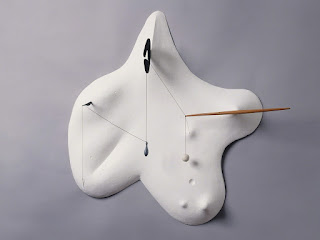VI: Self Interned at the Noguchi Museum
 |
| Yellow Landscape 1943 by Isamu Noguchi |
There is a clear shift in the style of the work Noguchi was producing before and after he interned himself. Prior to the self internment, Noguchi seemed to be doing portraiture work for the simple reason that is was the kind of work he could easily get commissions for and make money off of. Something changed when he went to the desert. Noguchi was first forced to work with different materials than what he was used to working with but more than that, Noguchi truly experienced despair at the internment camp. Through this new life experience, Noguchi seemed to be able to tap into a new creative energy.
He remarked on the surreal nature of his setting in Poston through a mail correspondence to fellow artist Man Ray. This surreal quality mixed with the overwhelming sense of despair that was inescapable at the camp was well displayed in the work, Yellow Landscape, made in 1943. This was a standout piece to me because I feel like it captured that combination perfectly.
 |
| Double Red Mountain 1969 by Isamu Noguchi |
A lot of the other work in the exhibition was made many years after Noguchi’s self-internment but still was heavily influenced by his time spent in the desert. One piece that I enjoyed quite a bit, Double Red Mountain, was made in 1969, over twenty-five years after Yellow Landscape. Double Red Mountain plainly conjures the images of the majestic and stoic mesas of the American southwest, yet at the same time, it has a human sensual quality to it. There seems to be multiple identities apparent in this work much like in Noguchi’s personal life. The work displays two nearly equivalent volumes held in visual tension as just they barely interact with each near their bases in the valley that they create. The finish of the piece entices the user to touch the smooth travertine from Persia posing as perhaps an American natural monument or perhaps a pair of breasts. For either, the work seems to be a rose tinted look back on his experience in the desert, which was quite formative and perhaps the beginning of his interest in landscape as a subject matter and medium alike.
#hadpratt, #hadsopratt, #hadstories, #hadhistoryofsculpture

Comments
Post a Comment